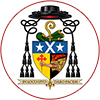Some fauna around the Abbey, April - May 2020
These days have surely been unprecedented not only for CV lock-down, but also for such an unbroken length of lovely Spring sunshine. Here at Pluscarden we have no guests, and almost no visitors either. But the fauna around the Abbey abound. We are fortunate to enjoy the cheerful sight of new calves and lambs in adjoining fields. The local roe deer, who wander freely, and almost fearlessly, through our grounds, have produced their fawns. We see few rabbits these days, but plenty of hares. Our red squirrels are frequently spotted. Recently a badger was seen wandering through our car park, just by the flag pole outside the Church. As for other small furry animals around the Abbey, one at least can be missed by nobody. Baxter the cat continues to dominate the life of the community from his comfortable residence in our East Cloister.
To mention some of our local bird life: the oyster catchers came in from the coast to scout out nest sites in the valley somewhat early this year, well before the end of February. Almost rivalling the racket they make have been the plentiful great spotted Woodpeckers, drumming on trees all around us, and at night, the tawny owls. Overhead, in very large numbers, greylag geese, commuting from coastal roost to inland grazing. We are also delighted to see curlews when they come directly overhead. Normally we have lapwings all about also: not spotted so far this year.
Barn Owl
The swallows arrived exactly according to schedule, on St. George’s day, 23 April. Our new wood chip sheds furnish them with ideal nesting sites. The warblers, also returning from Africa, made it to our valley before them. Among them all, the black cap in particular fills our estate with his penetrating song. Buzzards abound, after apparently a dip in population in recent years. So do, in particular, gold finches, and grey wagtails. The heron patrols our burn; the sparrow hawk leaves abundant signs of his dining habits all around; the jackdaws make their usual mess, and din, as they try to cram large twigs into small holes in our mediaeval masonry. We hear of a diminishment of thrushes elsewhere in the country, but we have plenty here, both mistle and song thrushes, and we see more snails than usual about, to supply their needs.
Two puzzling nocturnal creatures, often heard before, have been positively identified this year.
The first of these sounds a bit like an old man wheezing, or even snoring, very loudly. He sits on the Abbey roof; sometimes on the dormer window of a cell, giving its occupant the full benefit of his call, on and off through the night. He is a barn owl. Maybe he is just marking out his Spring territory. Some of us suspect though (without evidence) that he may be placing himself favourably to seize some of the many bats, mainly but not exclusively pipistrelles, who roost all around our buildings and fly especially at night.
Woodcock and earthworm
The second puzzling creature sounds like a flying frog. This particular frog though lets out not only the usual croak, but follows it with a high pitched squeak. And he flies, though only at dusk and dawn. He is a woodcock, engaged in his territorial display flight, known as “roding”. Our woodcock’s territory takes him right beside the Abbey buildings. Let no rival dare to come in, or there will be trouble.


